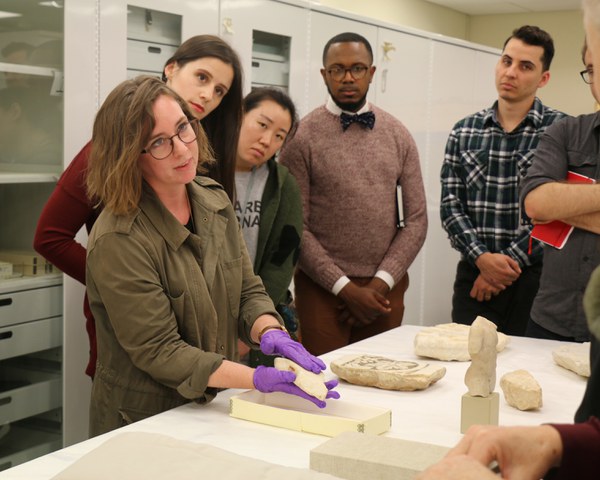By May Wang
This fall, we will welcome the tenth cohort of Tyler fellows to Dumbarton Oaks. The William R. Tyler Fellowship is a two-year program for Harvard graduate students in art history, archaeology, history, and literature in adjacent or related regions or time periods to our established programs in Pre-Columbian, Byzantine, and Garden and Landscape Studies. Former director of Pre-Columbian Studies Joanne Pillsbury first suggested the fellowship to then director Jan Ziolkowski, “who wisely took up the possibility and established a two-year fellowship for Harvard graduate students in a variety of disciplines,” current director Tom Cummins recalls.
The fellowship, named after the director of Dumbarton Oaks from 1969 to 1977, has “allowed scholars to pursue their research and to experience new areas of interest at Dumbarton Oaks,” says Cummins. This expansive approach has enabled Tyler fellows (almost three dozen to date) to pursue a diverse array of dissertation research and completion projects, including on Ottoman horticulture (Aleksandar Shopov, Center for Middle Eastern Studies and history); Moche mural painting (Lisa Trever, history of art and architecture); temple litigation in Korea in the long nineteenth century (Philip Gant, history and East Asian languages); and Latin poetic culture in the early medieval Mediterranean (David Ungvary, medieval Latin).
The Tyler Fellowship provides advanced graduate students with funding for over two years as well as a travel allowance. “The innovative structure has been refined over the years,” says Executive Director Yota Batsaki, “but from the beginning it has included a hands-on project that takes advantage of Dumbarton Oaks’ collections and staff experts to provide fellows with professional development opportunities.” Fellows typically spend the first year splitting their time between a project in the museum, library, archives, or publications and their own research. In the second year, fellows are welcome to continue using the resources of Dumbarton Oaks but often take advantage of additional travel funding for fieldwork or archival research.
This structure allows fellows to benefit from a full year in Dumbarton Oaks’ rich academic environment. Nathanael Aschenbrenner, Tyler fellow in Byzantine Studies from 2015 to 2017, noted that it was an opportunity “build professional connections with younger and older scholars.” These connections are lasting, too, Aschenbrenner says: “Several of the people I met at Dumbarton Oaks . . . I am still collaborating with.” He and Jake Ransohoff, Tyler fellow in Byzantine Studies from 2017 to 2019, edited the recently published volume The Invention of Byzantium in Early Modern Europe (2021).
Institutional projects, aimed at enhancing fellows’ research and professional skills, have also contributed to many fellows’ career paths. As a 2020 Alumni Outreach Report noted, “institutional projects [Tyler Fellows] worked on, while not their main purpose for being at Dumbarton Oaks, ended up being very useful for the careers they went on to have.” Coleman Connelly, Tyler fellow in Byzantine Studies from 2014 to 2016 and now a consultant at Deloitte, assisted in the Dumbarton Oaks Medieval Library (DOML), and noted that the Tyler Fellowship “absolutely prepared” him for his current job, even outside of academia. “Having that uninterrupted time to do serious research and becoming a master of areas of expertise that I previously hadn’t fathomed,” said Connelly, “was indispensable,” both for subsequent academic ventures and his current detailed and technical work.
John Davis (Garden and Landscape Studies, 2015–2017) assembled our DC “Water Atlas” digital resource largely with GIS (Geographic Information System). “I still use a lot of things I learned from doing that very GIS-heavy project now,” says Davis. “I taught it all to myself, and the heavy-duty use of [GIS] during the Tyler Fellowship allowed me to achieve a level of skill I wouldn’t have otherwise.” Philip Gant (Garden and Landscape Studies, 2017–2019) worked closely with the Rare Book Collection, especially some then recent additions to the East Asian holdings. Gant described his institutional project as “a great way to do paleographic training in a different medium” and an “exciting opportunity to be in charge of rare books and be handling them all the time.” Rong Huang, currently a first-year Tyler fellow in Byzantine Studies, has been assisting with the new permanent installation of the Byzantine galleries in the museum. “I thought the institutional project would be remote from my own research,” which is largely textually based, she says. “But working mainly with objects and material culture in the institutional project has inspired me to think about incorporating these aspects into my own dissertation.”
Tyler fellows’ institutional projects have made lasting contributions to Dumbarton Oaks’ offerings as a research institution, too. Tyler fellows in Byzantine Studies have regularly supported DOML’s editorial work for several years, proofreading translations and notes for the series’ texts in medieval Latin, Old English, and Byzantine Greek. Fellows across all three fields of study have supported digital initiatives like Davis’s Water Atlas and the Moche Iconography resource, one of our most popular digital resources. One of Gant’s auxiliary institutional projects was assisting with the launch of the Plant Humanities Initiative, including coauthoring a piece for Scientific American. In addition to Huang’s work with the Byzantine collection, current fellows Annick Benavides (Pre-Columbian Studies) and Chance Bonar (Byzantine Studies) have been working with the recent exhibition A Beautiful Dichotomy and DOML, respectively.
The contributions and successes of Tyler fellows are inspiring evidence that our fellowships offer an enriching opportunity to gain invaluable skills and to be surrounded by the next leaders in academia (over one third of the fellows have secured a professorship). As we reflect on a decade of these unique fellowships, we celebrate their past and ongoing work, both in their respective academic fields and to this home for humanists of many disciplines and career stages. “Tyler fellows have profoundly enriched Dumbarton Oaks with their enthusiasm, brilliance, and broad research,” says Cummins, “and, as with all our fellows, we feel so very fortunate to have them as part of our community.”
May Wang is postgraduate writing and reporting fellow.

